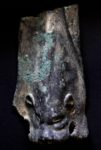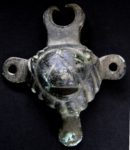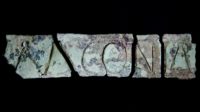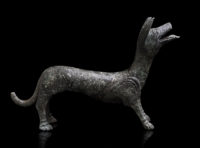
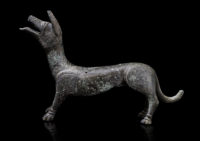
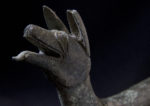 Metal detectorists Pete Cresswell and Andrew Boughton discovered a hoard of Roman bronze in Gloucestershire (the exact location is not being disclosed) that includes a figurine that is unique in Britain for its quality and size. It’s a free-standing bronze statuette of a dog with his tongue hanging out. Known as a “licking dog” figure, it is believed to have been a symbol of healing and may have some connection to the temple to Nodens, a deity of hunting, dogs and healing, at nearby Lydney Park.
Metal detectorists Pete Cresswell and Andrew Boughton discovered a hoard of Roman bronze in Gloucestershire (the exact location is not being disclosed) that includes a figurine that is unique in Britain for its quality and size. It’s a free-standing bronze statuette of a dog with his tongue hanging out. Known as a “licking dog” figure, it is believed to have been a symbol of healing and may have some connection to the temple to Nodens, a deity of hunting, dogs and healing, at nearby Lydney Park.
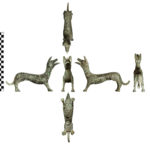 The dog stands at attention, his expression alert and focused upward, like he knows his master has a ball and is waiting for him to throw it. Holes drilled in his paws suggest he was once mounted to a base and there are two more holes on the upper left flank that may have once held pins that were part of the mounting system. There’s also a square hole on its underbelly. Each shoulder is decorated with a sideways teardrop-shaped panel incised with what could be stylized leaf or feather designs.
The dog stands at attention, his expression alert and focused upward, like he knows his master has a ball and is waiting for him to throw it. Holes drilled in his paws suggest he was once mounted to a base and there are two more holes on the upper left flank that may have once held pins that were part of the mounting system. There’s also a square hole on its underbelly. Each shoulder is decorated with a sideways teardrop-shaped panel incised with what could be stylized leaf or feather designs.
Cresswell, from Gloucestershire, said: “It’s not every day you come across a hoard of Roman bronze.
“We have been metal detecting for a combined 40 years, but this is a once in a lifetime discovery. As soon as I realised the items were of historical significance I contacted the local archaeology team, who were equally excited by the find.
“It’s a great privilege to be able to contribute to local and British history.”
 Archaeologist Kurt Adams, Gloucestershire and Avon Finds Liaison Officer, examined the hoard. He provisionally dated it to the 4th century (318 – 450 A.D.) and the exceptional dog is the only intact piece in the group excepting a coin or two. The other artifacts are all fragments, mostly made of copper alloy. They include pieces of a broken statue of a person wearing an elaborately draped garment, vase and furniture fittings, escutcheons shaped like animal and human heads, handle terminals, bangles, folded up banding from chests or boxes, a little spoon, a hinge and a great many bits and bobs of undeterminate origin. There’s even an inscribed copper alloy plaque broken into four pieces that when puzzled back together reads (V?)MCONIA. It is curved at the back, suggesting that it too was once mounted on something. These fragments appear to have been deliberately cut up or broken, perhaps by a metal worker collecting scraps to melt down for reuse.
Archaeologist Kurt Adams, Gloucestershire and Avon Finds Liaison Officer, examined the hoard. He provisionally dated it to the 4th century (318 – 450 A.D.) and the exceptional dog is the only intact piece in the group excepting a coin or two. The other artifacts are all fragments, mostly made of copper alloy. They include pieces of a broken statue of a person wearing an elaborately draped garment, vase and furniture fittings, escutcheons shaped like animal and human heads, handle terminals, bangles, folded up banding from chests or boxes, a little spoon, a hinge and a great many bits and bobs of undeterminate origin. There’s even an inscribed copper alloy plaque broken into four pieces that when puzzled back together reads (V?)MCONIA. It is curved at the back, suggesting that it too was once mounted on something. These fragments appear to have been deliberately cut up or broken, perhaps by a metal worker collecting scraps to melt down for reuse.
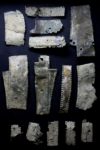 Intact or fragment, these objects are of great archaeological significance and require specialized treatment for their conservation and security. They are being kept at Bristol museum for the time being to give experts the opportunity to fully document, photograph and catalogue them. Once that task is complete, the British Museum’s Treasure Valuation Committee will assess the hoard’s full market value and recommend a reward to be paid in that amount, half going to the finder, half the to the landowner.
Intact or fragment, these objects are of great archaeological significance and require specialized treatment for their conservation and security. They are being kept at Bristol museum for the time being to give experts the opportunity to fully document, photograph and catalogue them. Once that task is complete, the British Museum’s Treasure Valuation Committee will assess the hoard’s full market value and recommend a reward to be paid in that amount, half going to the finder, half the to the landowner.
